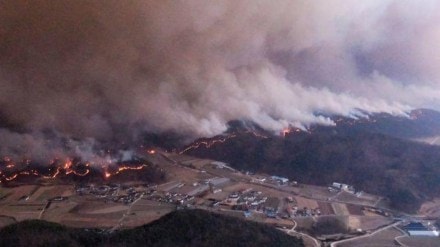South Korea is grappling with one of its worst wildfire disasters in history, as wind-driven flames continue to ravage the southern regions, killing at least 24 people and forcing the evacuation of 27,000 residents, officials said Wednesday. The fires, which broke out last Friday, have scorched more than 43,330 acres, destroying homes, factories, vehicles and even a 1,300-year-old Buddhist temple.
In a televised address, acting President Han Duck-soo described the wildfires as unprecedented in their scale and destruction. “Damages are snowballing,” Han said. “There are concerns that we’ll have wildfire damages that we’ve never experienced, so we have to concentrate all our capabilities to put out the wildfires in the rest of this week.”
Firefighting efforts have been severely hampered by strong winds, which fueled the flames overnight. Approximately 4,650 firefighters, soldiers and emergency personnel, backed by 130 helicopters, have been deployed to combat the blaze. Officials hope that a forecasted 5-10 millimeters of rain on Thursday will help contain the fires.
Cities under siege
The worst-hit areas include Andong, Uiseong, Sancheong and Ulsan, where firefighters continue to struggle against multiple fires driven by dry, gusty winds. While authorities had initially managed to control some of the flames on Tuesday, worsening conditions reignited the blazes, forcing fresh evacuations.
One of the most devastating losses came in Uiseong, where the historic Gounsa Temple, built in the 7th century, was reduced to ashes. However, officials from the Korea Heritage Service confirmed that some of the temple’s cultural treasures, including a stone Buddha statue, were rescued before the flames consumed the wooden structures.
While investigators are still determining the exact cause of the fires, officials suspect that human activities played a role. Possible causes include sparks from welding work and fires lit for clearing overgrown grass in family tombs, which may have spiraled out of control.
In response to the crisis, the Korea Forest Service has raised the wildfire warning to the highest “serious” level nationwide. Local governments have been instructed to increase emergency response efforts, restrict access to forests and parks and recommend that military units suspend live-fire exercises to prevent accidental fires.
Among the 18 confirmed casualties are four firefighters and government workers who were killed in Sancheong on Saturday after being trapped by fast-moving flames.
